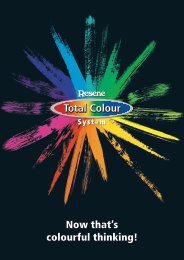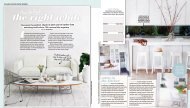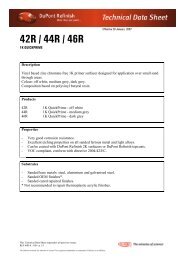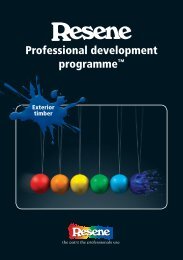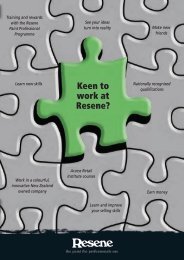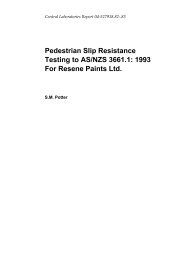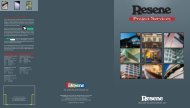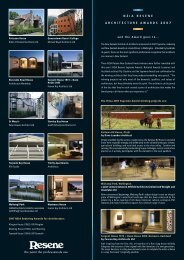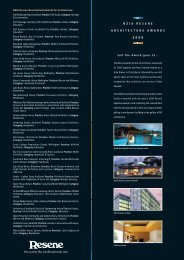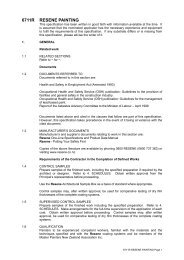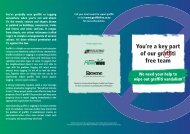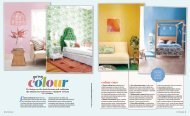Commercial - Resene
Commercial - Resene
Commercial - Resene
Create successful ePaper yourself
Turn your PDF publications into a flip-book with our unique Google optimized e-Paper software.
<strong>Resene</strong> Nirvana<br />
Colour Selection: Gerry Copas<br />
Photographer: Caryline Boreham,<br />
Brad Devcich<br />
Other Key Contributors:<br />
Lighting Payne Electrical<br />
That which is beyond words must always<br />
remain beyond words. It is the realisation<br />
of the limitation of language that<br />
encourages investigation into a more<br />
tangible examination and analysis that<br />
speaks of the unspeakable, and in doing<br />
so, attempts to overcome the impasse of<br />
inexpressibility.<br />
The process of neutralising the space and<br />
the objects within, subverts the reading<br />
of what we see as everyday things and in<br />
doing so, disrupts the signs that normally<br />
allow us to read and understand our<br />
surroundings.<br />
As a consequence this questions our<br />
fundamental acceptance in what we<br />
believe we know and don’t know; it is<br />
the absences that inject in us a sense of<br />
nervousness; the erasure of colour and<br />
the alteration to the materiality within<br />
the space, that creates an unsettling, a<br />
dislocation – it leaves us now finding<br />
ourselves having to cope with something<br />
beyond what we see. This enquiry is<br />
about what is not there as much as what<br />
is there. And how that affects our state<br />
of awareness. This is a kind of discourse<br />
of nothingness and the demarcation of<br />
neutrality within the practice.<br />
There is something disquieting about<br />
the process engaged and the result it<br />
produces. Something unaccountably<br />
strange occurs. There is a sense<br />
of cleansing or an act of spiritual<br />
purification that transcends the<br />
architectural space, something that goes<br />
beyond our own human experience or<br />
consciousness; something that provokes<br />
further investigation, seeking answers,<br />
as though searching for clarification<br />
regarding our own state of awareness,<br />
and the daily realisation of our own<br />
being of who we are, something which<br />
continually presents us with a multiple of<br />
absences rather than answers.<br />
We need to listen more closely, and<br />
observe more fervently in order to<br />
understand the presence and the<br />
absence; realising through the whitening<br />
out, that moment of nothingness, a<br />
pictorial sensibility.<br />
206<br />
The silence broken only by the sound of<br />
the silence being broken.<br />
Artist, Walter Kandinsky writes, “Colour<br />
is a power which directly influences the<br />
soul”.<br />
It is in that context that my final masters<br />
project of 2010 explored the idea of<br />
neutralising an architectural space by<br />
removing all colour as we know it. This<br />
was achieved through the whitening out,<br />
a site specific artwork, and the advice<br />
and ongoing support of <strong>Resene</strong>.<br />
White was chosen for its neutrality.<br />
White like its opposite, Black, is still a<br />
colour. In this instance the space chosen<br />
as my ‘canvas’ was the art utility room<br />
at Elam School of Fine Arts, Masters<br />
studios. This contained sinks, taps, pipes,<br />
toilet doors, wall telephone and other<br />
associated hardware – the entire space,<br />
walls, ceilings, floors, light fittings, light<br />
switches, power sockets, sprinkler cages,<br />
were all transformed to white. This<br />
required a large amount research and<br />
experimentation into paint suitability<br />
and durability due to the variation of<br />
materials. It was important that one<br />
white matched the other delivering a<br />
matt finish. This effect left audiences<br />
not quite knowing what was real and<br />
what was not. A key concern was<br />
the requirement to return the space<br />
afterwards to it original condition. Hence<br />
the temporal and restorative nature<br />
of the painted surface was also major<br />
consideration.<br />
The final selected paint was <strong>Resene</strong><br />
Waterborne Smooth Surface Sealer,<br />
chosen for its sanding quality, which<br />
allowed the surface to be buffed with<br />
400 grit wet and dry sandpaper in order<br />
to deliver a smooth finish. The walls and<br />
floor joints were filled with <strong>Resene</strong> Gap<br />
Filler, the idea being, to create a seamless<br />
look to the room. The wall telephone and<br />
window glass within the access doors<br />
were also treated the same. The floor was<br />
painted with a white <strong>Resene</strong> Lumbersider<br />
for hardwearing finish during the threeday<br />
public opening to the space at the<br />
end of year graduate exhibition.<br />
White



